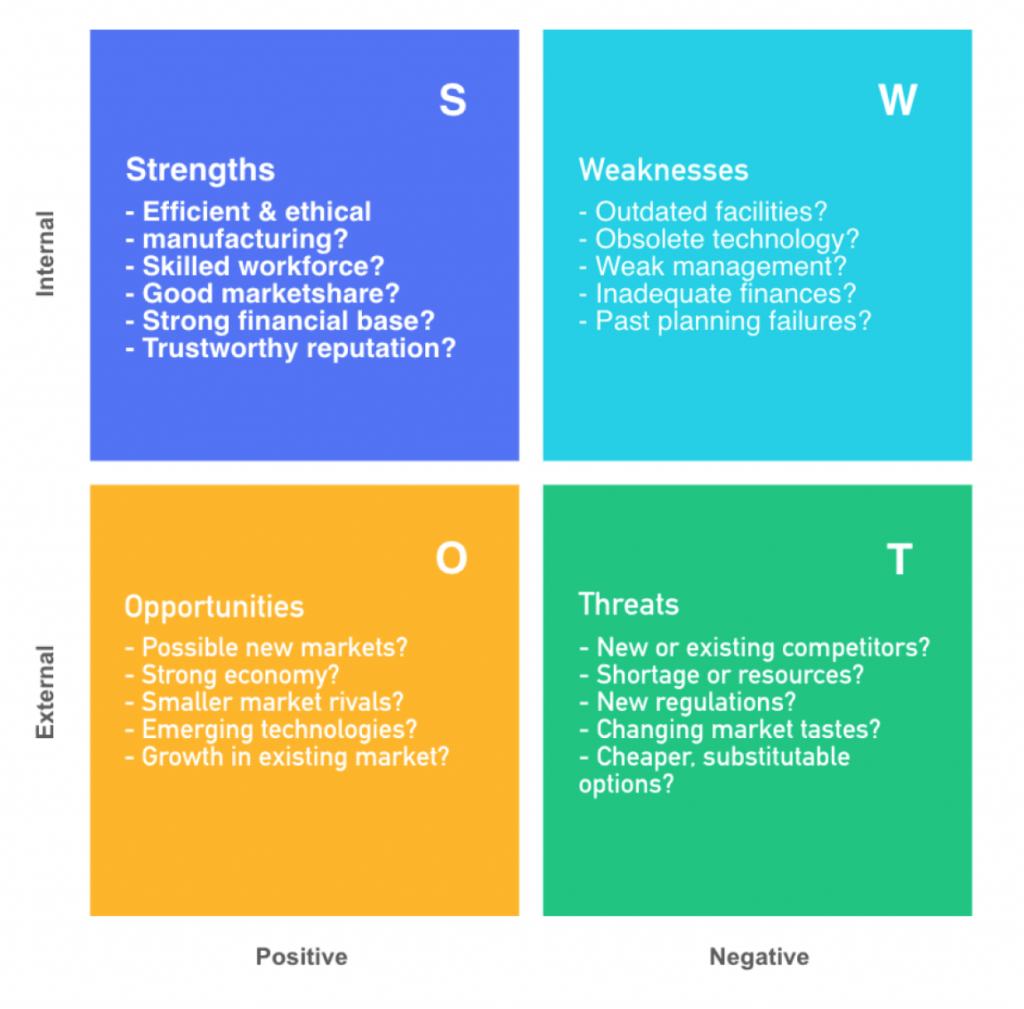Table of Content

- Digital Marketing
What is SWOT Analysis & How Can I Use It?
This article will provide an in-depth description of the SWOT analysis as a tool that can be used in your company, whether it is a small business or a large global corporation.
What is SWOT Analysis?
A SWOT analysis is one of the most common analysis models for analysing a company’s situation. However, the model is very versatile and can be used in a variety of other contexts, including as an insight for your digital marketing.
Therefore, in the following, we will present you with a thorough review of the SWOT analysis and how you can apply it in your company.
SWOT is an acronym that stands for Strengths, Weaknesses, Opportunities, and Threats. Albert Humphrey developed the model while working as a researcher at Stanford University in the 1960s.
He developed the model for a large research project that entailed analysing large corporations and determining why strategic planning sometimes fails.
Initially, the model was known as “SOFT,” which stood for Satisfactory, Opportunity, Fault, and Threat. Fault was replaced with Weaknesses around 1965, and Satisfactory was replaced with Strengths over time.
The SWOT analysis, on the other hand, is still essentially the same model as the SOFT model was in the 1960s.
Interested in growing your business with digital marketing? Get in touch with a digital marketing agency Bangkok like IBEX today.
The SWOT analysis is a method of clearly and insightfully listing all of a company’s most important external and internal conditions.
The analysis is divided into four areas, each represented by a different word (or letter), and the goal is to define the company’s own conditions in each area to gain insight into the company’s health. SWOT analysis is divided into two categories: “external conditions” and “internal conditions.”
This additional division informs you about the conditions that are controlled internally in your company or whether they are dependent on external factors that are beyond your control.
The internal conditions are Strengths and Weaknesses.
The external conditions are Opportunities and Threats.
The primary goal of the SWOT analysis is to provide answers to the following questions:
- Which areas should we prioritise for immediate improvement?
- Where is the most room for growth and market potential?
- What are the most serious threats to our company’s and market position right now?
When conducting a SWOT analysis in your company, not all areas of the SWOT analysis are of equal importance.
If you are conducting an annual health check on your company, it is unlikely that you will need to expend so much time and effort on delving into the “threat level,” such as a company entering a new market or undergoing a major strategy shift.
Furthermore, the SWOT analysis is frequently used as a model to pick up on the findings of a larger situation report.
Once you’ve identified the most important points in each area, you can move forward with concrete initiatives and strategies that take into account all of the opportunities and challenges.
What is the SWOT analysis used for?
When it comes to assessing a company’s health, agility, robustness, market positioning, and readiness for change, among other things, the SWOT analysis is one of the most widely used tools in the corporate toolbox.
Because the SWOT analysis provides an overview to both management and individual employees, it can create value for multiple layers of an organisation – whether it is a large global corporation or a startup in the go-to-market phase.
The SWOT analysis does not automatically provide solutions, nor is there a single definitive solution to the challenges revealed by the SWOT analysis. The claim of a single definitive solution to your problems, on the other hand, should raise most people’s brows to the hairline and be met with scepticism.
Furthermore, a SWOT analysis is not a quick fix, either in terms of preparation or in terms of planning and prioritization of subsequent focus areas.
In turn, the SWOT analysis can provide a company with insight into its resilience to time and society, as well as defining the focus areas that are relevant to prioritize and work purposefully with.
Although solutions are not served on a silver platter with a detailed to-do list, an overview of challenges, strengths, and opportunities can provide an indication of what type of strategy will be appropriate.
As a result, you will receive tailor-made solutions for your company that take into account factors such as the company’s specific customer group, brand value, future goals, and sustainability strategy.
Strengths
Strengths is one of the model’s two internal conditions, and thus a condition over which you have authority in the company. This is where you fill in everything your company is good at, especially areas where you outperform your competitors.
Examples of strengths include: strong finances, high customer satisfaction and loyalty, efficient production, and productive employees etc.
It is critical to find new initiatives after identifying the company’s most important strengths. Here, you can use your strengths or choose to build on them in order to keep them as the company’s strengths.
Weaknesses
Weaknesses are an internal relationship for the company as well.
In this section of the analysis, one looks inward to see if, for example, competencies are lacking or if there are areas where the company is not performing well enough in comparison to competitors. It is not here that you will find solutions or determine how difficult it will be to solve a potential challenge. Weaknesses can include things like expensive and inefficient production, liquidity issues, a lack of internal communication or poor marketing, and so on.
Because the weaknesses are found within the organisation, it is critical that your company accept responsibility for the points you enter here. Finding the company’s weakest points allows you to determine what measures are required to reduce these weaknesses so that they have as little impact on the company as possible.
Opportunities
Opportunities are one of the two external factors, and you must identify those that are beyond the company’s control. When it comes to external factors, it’s important to remember that these are opportunities at a societal structural level. It is necessary to conduct research before selecting and defining the specific options that make the most sense for the company to pursue or act on. Many people make the mistake of listing points that should actually be listed under Strengths in this section of the SWOT analysis.
However, in ‘Opportunities,’ the focus is on what opportunities the company has at a macro level, rather than within the company’s own framework. You can accomplish this, among other things, by determining which specific options are available on the market that make sense for your company to investigate and pursue. It could be new potential customers, new market trends, or changes in the law. External opportunities include, for example, a boom, technological development, favorable legislative changes, and new markets. Avoid mentioning things like better branding opportunities, positive publicity, or new customers, as these are examples of areas and factors on which your company can have a direct impact.
After researching the opportunities that are most important for the company’s or product’s future, you can then take concrete initiatives that make the best use of these opportunities in a competitive manner.
Threats
Threats are the final area of analysis and, as previously stated, are also classified as external factors. These are the conditions that can either complicate a company’s efforts to achieve its objectives or threaten the company’s very existence. These threats can include factors such as new and existing competitors in the industry, new technologies, a recession or economic crisis, or new legislation that will affect one’s industry, such as stricter rules for the sale of one’s products, among others.
Under Threats, it may be necessary to look into the crystal ball to identify potential challenges that may arise, and then devise measures to reduce or deal with these potential risks.
This section of the SWOT analysis is not concerned with predicting and preventing the next financial crisis, but rather with determining whether it is worthwhile to develop a crisis plan with an information hierarchy in the event of, say, an earthquake in a production country.
How Do I Get Started?
After reviewing the four areas and gaining a basic understanding of the SWOT analysis, you can begin collecting the data required to identify the points for the various areas.
You can set up your SWOT analysis however you want and use whatever systems or tools you want, such as Excel.
The most important aspect is that you will be able to identify the 3-5 most important elements in each of the four areas. The art of limitation is not always easy, and this is where you must work hard on sorting and prioritising so that your SWOT analysis is as actionable as possible.




![happy-young-asia-businessmen-businesswoman-meeting-brainstorming-some-new-ideas-about-project-scaled (1) Top 10 Digital Marketing Agencies In Thailand [2024]](https://www.ibex.co.th/wp-content/uploads/elementor/thumbs/happy-young-asia-businessmen-businesswoman-meeting-brainstorming-some-new-ideas-about-project-scaled-1-qji23hztd22xdvln8gjfucufhgiekie3sh7loq8di6.webp)





